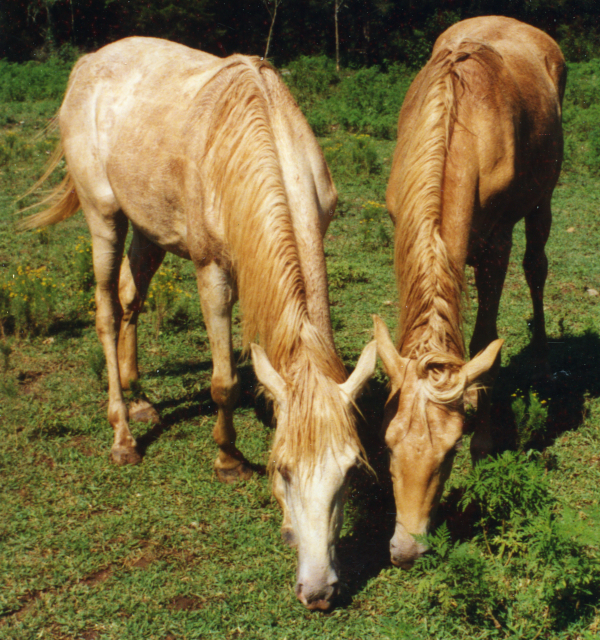Quick Summary

Click here for Price and Turnaround Time
Phenotype: Champagne is a coat color dilution responsible for diluting both red and black pigment as well as causing pinkish/lavender skin and amber-colored eyes.
Mode of Inheritance: Autosomal dominant
Alleles: N = Normal or non-dilute, Ch = Champagne
Breeds appropriate for testing: Miniature Horse, Missouri Fox Trotter, Quarter Horse and related breeds, Spanish Mustang, Tennessee Walking Horse, related breeds
Explanation of Results:
- Horses with N/N genotype will not be champagne dilute and cannot transmit this champagne dilution variant to their offspring.
- Horses with N/Ch genotype are dilute and may transmit this champagne dilution variant to 50% of their offspring. Matings with N/N genotype will result in a 50% chance of producing a champagne dilute foal.
- Horses with a chestnut base coat color and Ch/N genotype will have a gold coat often accompanied by a flaxen mane and tail.
- Horses with a bay base coat color and Ch/N genotype will have tan coat accompanied by brown points.
- Horses with a black base coat color and Ch/N genotype will have a dark tan coat accompanied by brown points.
- Horses with Ch/Ch genotype are dilute and will pass this champagne dilution variant on to all of their offspring.
- Horses with a chestnut base coat color and Ch/Ch genotype will have a gold coat often accompanied by a flaxen mane and tail.
- Horses with a bay base coat color and Ch/Ch genotype will have tan coat accompanied by brown points.
- Horses with a black base coat color and Ch/Ch genotype will have a dark tan coat accompanied by brown points.
Horse Coat Color Panel
$85 per animal
Full Color/Pattern Panel
$155 per animal
Sample Collection
Horse DNA tests are carried out using cells from the roots of a hair sample (roughly 20-40 hairs).
1. Grab about 10 hairs at the base.
2. Wrap the hairs around your finger and give it a quick pull.
3. Check the ends to make sure the pulled hairs have roots.
4. Repeat the process until you have collected about 20-40 hairs with intact roots.
5. You can choose different places on the mane or tail. NOTE: For foals, we recommend pulling all hairs from the tail only.
6. Tape the hairs to the submission form and fold the form along the dotted line to protect the sample. Do not use ziploc bags as they can cause condensation that allows mold to grow on the hair.
7. Place the folded form containing the sample in a paper envelope and mail it to the laboratory.
Champagne is a dominant trait that dilutes hair pigment from black to brown and red to gold. Champagne on a chestnut background (Gold) produces a gold body color and often a flaxen mane and tail that can be mistaken for palomino. Champagne on a bay background (Amber) produces a tan body color with brown points. Champagne on a black background (Classic) produces a darker tan body with brown points. The skin of Champagne-diluted horses is pinkish/lavender toned and becomes speckled with age; the speckling is particularly noticeable around the eye, muzzle, under the tail, udder, and sheath. The eye color is blue-green at birth and darkens to amber as the horse ages.
Champagne is inherited independently of other coat color genes and thus this dilution can occur in combination with any of the other genes that modify the base colors. Champagne dilution is found in Tennessee Walking Horses, Missouri Fox Trotters, Quarter Horses and related breeds, Miniature Horses and Spanish Mustangs, among others. The increasing popularity of this color is making it more common in these breeds.
A mutation in exon 2 of the Solute Carrier 36 family A1 (SLC36A1) (c.188C>G) gene causes the champagne dilution.
Testing for this champagne dilution variant can assist owners and breeders in identifying homozygous individuals (Ch/Ch) if the champagne phenotype is desired. Horses with Ch/Ch genotype will always pass on the champagne allele to their offspring and thus will consistently produce offspring with a champagne phenotype.
